Shortly after the stamped-receiver AKM rifles went into mass production, Mikhail Kalashnikov and his bureau of technicians and engineers produced what is arguably best general-purpose machine gun in use today. It was adopted into service in 1961 after a surprising upset of a GPMG design by Nikitin. Mechanically, the PK is basically an AK action flipped upside down, to allow for a belt feed on the top of the receiver instead of a box magazine on the bottom.
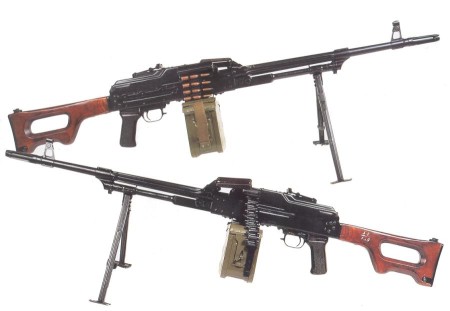
Like the AK, the PK makes clever and effective use of design elements from several other guns. The mechanism for pulling cartridges out of the belt is taken from the Goryunov SG43, the design of the feed pawl (which is directly powered by the gas piston upon firing) comes from the Czech vz52 LMG, and the barrel quick-change mechanism also comes from the Goryunov. The rotating bolt and gas piston design are form the AK, with the addition of a manually adjustable gas cylinder.
Copying the German doctrine of the universal machine gun, the PK was adopted simultaneously in several different configurations – the regular PK with its integral bipod for infantry use, the PKS mounted on a lightweight tripod for emplacements and better supporting fire, the PKB with spade grips and mountings for armored vehicle use, and the PKT for coaxial tank use, with a remote firing solenoid trigger in place of the stock and pistol grip.
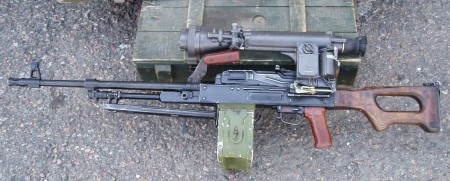
The PK design is an excellent one, and very reliable. It makes very good use of stampings, which the Russians had spent nearly 15 years perfecting for the AK rifle. It is interesting to compare the PK to the US contemporary M60 design, which is a technically quite poor design. On paper the two guns share many common features (long gas piston, stamped receiver, rotating bolt, etc), but the PK was based on a gun completely understood by its designer (the AK), while the M60 was developed from the German MG42 and FG42 by a team that really didn’t understand the subtleties of its parent designs.
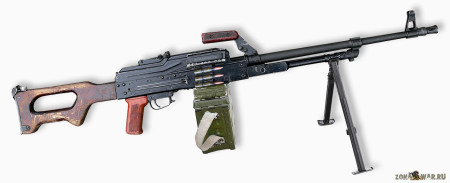
In 1969, the design was revised and given the new designation PKM (modernized), along with the PKMS and PKMT. The new version was lightened to 16.5 pounds (down from 19.8), and can be distinguished by a short flash hider, smooth barrel, and ribbed top cover (the original PK has a half fluted barrel, smooth top cover, and long flash hider). Both versions continue to use the antiquated-but-effective 7.62x54R cartridge and metal belts compatible with the Maxim and Goryunov machine guns. The PK and PKM have been adopted and manufactured by many different countries, including pretty much the entire Soviet Bloc.
We have several manuals available for download, thanks to Robert who sent us all three of the English-language ones. You can grab them from the PK/PKM page in the Vault.
On a humorous note, we would like to point out that the PK is apparently the weapon of choice for Taliban Rambo, who is actually somehow able to hit even less than American Rambo:
https://www.youtube.com/watch?v=gUcpvDYabiI

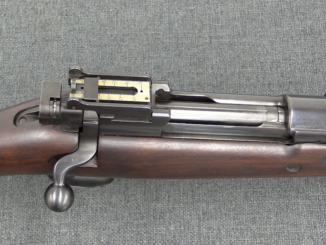
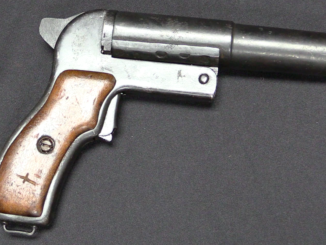

Was the camera on a tripod? or was the cameraman wanting to meet his virgin [goats] early?
That guy’s either got world-class arms, or the PKM has a world-class muzzle brake. I don’t think I could’ve done that.
Maybe that’s the Taliban’s version of tossing the caber?
Its the beard. Beards afford the wearer great strength, confidence, and fortitude.
Wow on the video. His beard must give him great strength.
But seriously, great article. The PKM is a pretty excellent design. Have they rechambered it in 7.62 NATO for export? Seems like it’d be a winner despite the domination of the 240 in NATO or Western-aligned nations.
Polish engineers have reworked the design for use with 7.62mm NATO and the M13 belt link. They call it the UKM.
I think the PKM is about as forgotten as the Corvette, but that doesn’t mean I didn’t read every word with appreciation. I love Russian guns!
Don’t forget the PKP… that one is a bit more off the radar perhaps…
One way or the other, this does demonstrate the superb balance and user-friendly controllability of the PKM, even in the dismounted mode.
Yep, I’m all for it – the PKM rulez. AND – it’s only 7,5-kg (16,5 lbs) heavy, yet reliable as a rock, much better in a LMG role than the M60 or (especially) the MAG/M240. Also, PKM is still modern today, while MAG looks more and more like a Stone Age product, mating M1917A1 receiver, BAR action and MG 42 belt transfer thrown in for a pretense of modernity.
Talking about the recycled ideas, the belt transfer in PK inspiration goes a bit further than Czechoslovak LK vz.52: the Czechs took it from a German machinegun, the MG39Rh by no less than Rheinmetall’s Louis Stange, of MG34 and FG42 fame. The MG39Rh was a gas-operated weapon with many interesting features, like three-pronged Mercedes-star sectioned firing pin, tilting breech-block lock, and a peculiar oscillating guilotine style stirrup-shaped ejector in conjunction with solid, Browning-style extractor grooves on the bolt face. Oh, and the bolt is triangular in section… I wrote it up for Ian, so – stay tuned, folks!
During my Finnish conscription, I got to use the PKM on some occasions. I must say, ive never handled a gun with more confidence, it even tops the Rk62 and 95. During my 1 year time in the marines, I saw at least a handful of jams on the assault rifles, and had one or two of my own but with the PKM – not even heard of!
I especially remember one time coming ashore from our landing craft we came under fire, and I was using the PKM loaded with 200 round non desintegrating belts without beltcans (typical rambo style) thanks to some failure at the central supply station. Theese belts of course tangled up into everthing in the vicinity of our approach – seagrass and its roots complete with lots of mud, saltwater and sand. I was sure that any second now, the gun will give up, but no – the belt pulled the seagrass inside the reciver where the mechanism made short work of it cutting it up into small pieces and sending (most of it) out with the empty brass.
Since then, Ive used Ksp58B/FN MAG in the Swedish defence forces, where its often dubbed the best machinegun in the world. Its an okay gun I guess, but in every category: Weight, accuracy, relaiability, userfriendlyness ect – the PKM comes out on top, sometimes without a contenst. Any day, Id switch back to it.
Excuse my almost complete ignorance of the Russian language – perhaps almost complete ignorance is far more dangerous than an absolutely complete ignorance.
Kalashikova; Literally, “Daughter of Kalashnikov”?
Is the matronymic because the word for machinegun is “Femminine” or is Mikhail Timmofeyovitch, literally the “mother” of the gun? rather than it being “Pulemet Kalashnikovitch”?
“Daughter of Kalashnikov” would be “Kalashnikovna” – “Kalashnikova” is a wife :-)Timofeyevich is a patrimony for a son of Timofey (a Scandinavian would be Timofeysson) – a doughter would be “Timofeyevna” (a Scandinavian would be Timofeysdottir). But seriously it’s not a gender problem – it’s just grammar. “Pulyemyot Kalashnikova” means a “Machine gun by Kalashnikov” or “of Kalashnikov”. The big difference and definitely an advantage of English as a foreign language to me is the absence of declination forms, which makes it a super easy language to learn and use (BTW – Chinese is another example of declinationless language). My native Polish is WAY much more complicated (declination PLUS gender forms PLUS single/multiple forms) – but it’s also the way it is with most European language families: Romanic (French, Italian, Spanish, Portuguese), Germanic (German, Dutch, Swedish, Danish) and all Slavic languages.
…and all Slavic languages.
Bulgarian has no case declension.
OK, so count the Bulgarians out. Sorry, I can’t speak Bulgarian.
Despite Bulgarian being full of these http://en.wikipedia.org/wiki/False_friend (at least with respect to Russian), it’s supposed to be on average the most intelligible to speakers of other Slavic languages.
Thanks Leszek,
I have to own up to being terrible at languages, partly lack of ability, but mostly laziness.
I can sort of understand spoken Italian (Napoli dialect is easier, it must be the Norman influence there), and I navigated through a Romanian menu to set my aging father’s phone back to English language a few days ago,
but trying to navigate a colleague’s computer that was set to Polish…
Polish children must be very clever.
They sure are – like all children. But then they go to school and all of a sudden all they can count is your money…
Without getting into the sundry and complex details of the various characteristics of different GPMG’s in a direct comparison — most of which the knowledgeable readers and contributors on this website are all too familiar with, anyway — I think the PKM is probably the best GPMG in the world today due to the fact that it performs exceedingly well in all areas by which a weapon is judged, i.e., durability, reliability, accuracy, firepower, user-friendliness, ergonomics, availability of ammunition, balance, controllability, ease of maintenance, weight ( or lack thereof ), portability, etc. Last but not least, the PKM has compiled a real-time record on the modern battlefield that is second to none. There are many fine GPMG’s that perform well in several of these arenas, and outstandingly ( as in best of the best ) in a few, or a combination thereof, but none can equal the PKM’s overall performance.
I, for one, am very partial to the FN MAG58, which I am intimately familiar with, and which was the standard GPMG in use when I was in the service. There are also so many excellent rival designs such as, to name a few, the MG3, MG42/59, M60 ( especially the E3 and E4 versions ), HK21A, HK21E, AA52, Swiss MG51, SIG 710-3 and Brazilian Uirapuru. All have outstanding characteristics in their own right, but again, none are as well-rounded as the PKM, regardless of how you cut it. And therein lies its brilliance as a world-beating design that has largely gone unappreciated in the West.
I never realized the PK/PKM could ever be a forgotten weapon, seeing as just how many people like it.
Not to mention every shooter game seems to have to include the PKM.
I like the PKP Pecheneg myself, especially considering they made a bullpup version of it. And the PKP Pecheneg is already a lewis gun crossed with a PKM, and then they made it a bullpup.
I am partial to the RPD. and was quite thrilled when various guys started turning RPDs in to my team. I thought we’d TI them and issue them to our ANA dudes, but they were not having any. They wanted the PKM. Nobody was turning in PKMs. Make of that what you will!
There is one thing where the PK needs improvement, same as all Russian and Russian-inspired weapons: corrosion control. Yeah, they have some chrome plating, but their metal finishes are century-old technology. A US or EU LMG can stand a rainstorm and overnight outdoors without turning orange. PKM, not so much.
They would sure turn orange – but they will still work despite that, and that’s all that counts. Military small arms are tools of a trade, not objects of art, and reliability trumps aesthetics.
I guess that says a lot about the desirable qualities of the PKM, as well as the fact that soldiers everywhere tend to favour what they perceive as the more prestigious weapon! That’s just too bad, because I’ve always felt that the RPD is in many ways an almost-ideal dedicated LMG — light, simple, powerful yet with relatively low recoil, reliable, durable, easy to disassemble and service, inexpensive, functional and workmanlike, and chambered for that most iconic of modern cartridges, the Russian 7.62mm x 39. When one reads up on articles by various authors about the RPD, one gets the distinct impression that, as a whole, it is considered a good but not outstanding weapon. For that reason, I feel that it has been unfairly judged and somewhat underestimated. It has actually had an excellent track record on the battlefield in all climates ranging from the extreme heat and humidity of the jungles in the Congo and the dry dusty sand seas of Saharan Africa to the freezing cold, wet winters of Eastern Europe and The Balkans.